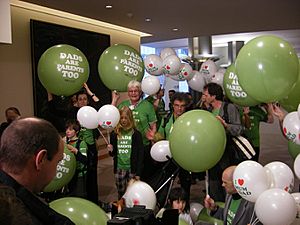Parental leave facts for kids

Parental leave or family leave is a special benefit that allows parents to take time off from their jobs to care for a new child. This time off can be paid, meaning parents still get some or all of their salary, or it can be unpaid. The main goal of parental leave is to help parents bond with their new baby or adopted child and make sure the child is well cared for. This benefit is available in almost all countries around the world.
Contents
What is Parental Leave?
Parental leave is a type of employee benefit. This means it's something extra that companies or governments offer to their workers, beyond just their regular pay. It's designed to support families when a new child joins them. The rules for parental leave, like how long it lasts or if it's paid, are often set by laws in each country.
Why is Parental Leave Important?
Parental leave is very important for several reasons. It allows parents to spend crucial time with their new child right after birth or adoption. This helps parents and children form strong bonds. It also gives parents time to adjust to their new family life. For example, they can learn how to care for a newborn or help an adopted child settle into their new home.
Benefits for Children
When parents have time off, they can focus completely on their child. This helps with the child's early development. Babies and young children need a lot of attention and care. Parental leave makes sure they get this from their parents during their most important early months. It can also lead to better health for children.
Benefits for Parents
Parental leave helps parents manage the big changes that come with a new child. It can reduce stress and help parents feel more connected to their families. For mothers, it allows time to recover after childbirth. For all parents, it provides a chance to share the responsibilities of caring for a new family member.
Benefits for Families
When parents can take leave, it supports the whole family. It can help families balance work and home life better. It also promotes equality by allowing both mothers and fathers to take an active role in caring for their children. This can lead to stronger, happier families.
Types of Parental Leave
Parental leave includes different kinds of time off, depending on the parent's role and how the child joins the family.
Maternity Leave
Maternity leave is for mothers, usually after they give birth. It gives them time to recover from childbirth and to care for their newborn baby. This type of leave has been around for a long time in many countries. It recognizes the physical demands of pregnancy and birth.
Paternity Leave
Paternity leave is for fathers. It allows them to take time off when their child is born or adopted. In the past, paternity leave was not as common as maternity leave. However, more and more countries and companies now offer it. This helps fathers be more involved in their child's early life.
Adoption Leave
Adoption leave is for parents who adopt a child. It gives them time to welcome their new child into the family. This leave is important because adopted children, especially older ones, may need time to adjust to their new home and family. It helps parents build a strong relationship with their adopted child.
Paid vs. Unpaid Leave
Parental leave can be either paid or unpaid.
- Paid leave means that parents continue to receive some or all of their salary while they are not working. This helps families financially during a time when they might have extra expenses.
- Unpaid leave means parents can take time off, but they do not get paid for it. Even unpaid leave can be helpful, as it protects a parent's job while they are away.
Many countries have laws that require employers to offer a minimum amount of parental leave, often paid. Some companies offer even more generous leave policies than what the law requires.
History of Parental Leave
The idea of parental leave has changed over time. In the past, only mothers typically received leave, and it was mainly focused on their recovery from childbirth. Over the years, as ideas about family roles and gender equality evolved, the concept expanded. Now, parental leave often includes fathers and adoptive parents, recognizing that both parents play a vital role in a child's life. Many countries started introducing or expanding parental leave laws in the late 20th and early 21st centuries.
Images for kids
See also
 In Spanish: Permiso por paternidad para niños
In Spanish: Permiso por paternidad para niños






